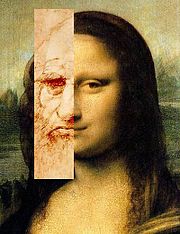- Lillian Schwartz
-
Lillian F. Schwartz (born 1927) is an American artist who is known for being a creator of 20th century computer-developed art. One notable work she created is Mona Leo, where she morphed the image of a Leonardo da Vinci self-portrait with the Mona Lisa.
She made one of the first digitally created films to be shown as a work of art, Pixillation, which shows diagonal red squares and other shapes such as cones and pyramids on black on white backgrounds.
She worked in the early stages of her career with Bell Laboratories, developing mixtures of sound, video, and art. Afterwards, during the 1980s, Schwartz experimented with manipulating artwork images using computer technology and creating artwork of her own.
Contents
Experiments with Leonardo's works
Schwartz used the works of Leonardo Da Vinci extensively in experiments with computers. She used a 3D computer-generated model to show that the lines on the Santa Maria delle Grazie in Milan match the perspective lines of Leonardo's fresco painting of the Last Supper.
Similarly, in Mona Leo, she replaced the left side of the Mona Lisa with a flipped left side of the red chalk portrait of Leonardo, arguing that the Mona Lisa is a self-portrait by da Vinci. Using lines drawn on the image, the picture depicts the bottom of the eye, eyebrow, nose and chin aligned together. She also removed the grey tones in Leonardo da Vinci's self portrait and superimposed the Mona Lisa eye over it in further experiments. One argument about this alignment is that the similarities are due to both portraits being created by the same person using the same style. Additionally, though the drawing on which she based the comparison is held to be a self-portrait, there is no historical evidence to support this theory.
Computer imagery
Schwartz uses computers to manipulate many other images which relate to art and art history. Schwartz's experiments with computers to manipulate images were done before digital art became more widely used in the late 1990s. She uses shapes generated by a computer to make images on the computer screen, such as using trapezium shapes to create an object such as a cat, as well as triangle shapes to represent a human head. She has experimented with ways to superimpose multiple images onto another image in an effect of a collage, as with her works of Statue of Liberty and Homage to Van Gogh. She also warped images of faces of Rembrandt into a photo of Albert Einstein, as a means of attempting to show similarities in the facial features. Further, she combined images of works of art in a poster for the Museum of Modern Art in New York for her poster Big MoMA.
References
- Antoinette LaFarge. 'The Bearded Lady & the Shaven Man: Mona Lisa, Meet Mona/Leo'. Leonardo: The Journal of the International Society of Art, Science, and Technology, Vol. 29, No. 5 (October 1996).
External links
Categories:- American artists
- 1927 births
- Living people
- Digital artists
Wikimedia Foundation. 2010.


